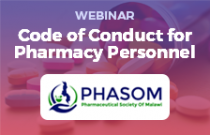Code of Conduct for Pharmacy Personnel
Associate Professor Felix Khuluza
In this webinar we will discuss the code of conduct for Pharmacy Personnel
Migraine: Diagnosis and Management
Dr. Freda Dodd-Glover
An overview of migraine and current trends in management.
DEA MATE Act Substance Use Disorder 4-Activity Package
Mary Kathleen Ebener, Margaret A. Clark
The recently enacted Medication Access and Training Expansion (MATE) Act, requires that Drug Enforcement Administration (DEA)-registered health care providers (except those in exclusive veterinary practice) complete training on the treatment and management of opioid or other substance use disorders. This mandated eight (8) hours....
Showcase of a Community Quality Improvement Model for Maternal and Child Health Services in Kenya
Rachel Ambalu
Maternal and child health outcomes in Kenya have for a long time been hindered by poor quality and underutilization of services particularly in low-income and rural households. In Kenya, guidelines have been developed and activities undertaken aimed at improving the quality of health services in health facilities and communities....
World Breastfeeding Week: Empowering Parents, Enabling Breastfeeding
Henry ENUNU
This year’s World Breastfeeding Week, held from August 1st to 7th, focuses on the theme "Let's make breastfeeding and work, work!" The presentation will delve into strategies for creating supportive workplaces that enable breastfeeding, emphasizing the importance of United Kingdom extended maternity leave and necessary workplace....
Communication in Dynamic Times: Compassionate Conversations During Pregnancy
Dr Nalo M Hamilton PhD, MSN, APRN-BC
In this lecture the learner will learn ways to effectively & compassionately communicate with the pregnant, labouring, and post-partum woman
X-ray: The Appendicular Skeleton (Adult)
Dorothy Keane, Claire Giles, Paul O'Riordan, Sarah Gallimore, Joanne Hargreaves, Nick Woznitza, Kevin Harvell, Kathy Dewar, Tracy O'Regan, Kara Mell
The courses in this learning path cover content relevant to image interpretation of the adult appendicular skeleton: Please note that while these e-learning sessions include information on how to write up a report, they will not qualify you to become a reporting radiographer.
Primary Health Care: The Foundation for Universal Health Coverage
Mr Basiru Taofeek Adekola
This presentation explores how Primary Health Care (PHC) serves as the essential groundwork for achieving Universal Health Coverage (UHC). It examines PHC's unique role in providing accessible, comprehensive, and affordable care, especially in underserved areas. Key topics include how PHC promotes health equity, supports disease....
Target Controlled Infusions
Sue Hill
This session will develop the three compartment model to include an effect-site and discuss its application to target-controlled infusions used for induction and maintenance of anaesthesia. The concept of context-sensitive half-time will be introduced.
Nitrous Oxide and Xenon
Tom Peck
This session covers the storage, production and physicochemical properties of nitrous oxide, N2O. It moves on to examine the Concentration Effect and Second Gas Effect. The physicochemical properties of xenon, Xe, are detailed, along with its similarities and differences to N2O.
Prescribing Exercise or Physical Activity in Primary Care
Dr Lorraine Nyakudanga
Regular physical activity which includes exercise has been proven beyond doubt to have both physical and psychological benefits. Including treating and preventing chronic disease, lowering mortality rates, and improving mental health and cognitive function. For these reasons and the fact that primary care is the first, and some....











